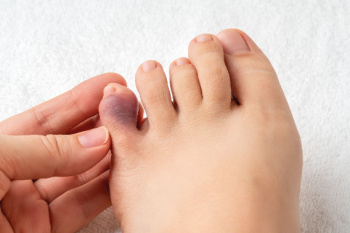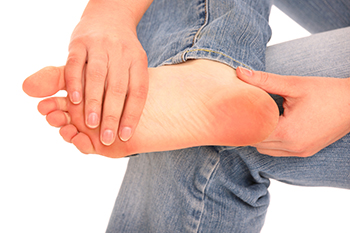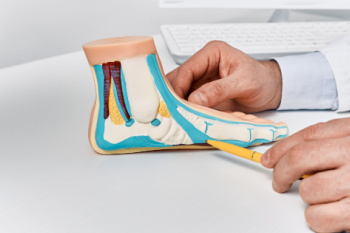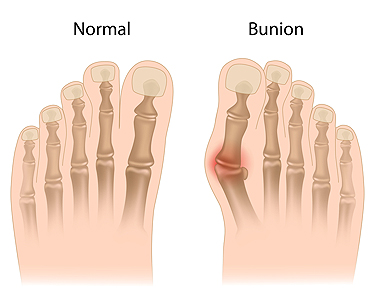Items filtered by date: March 2024
Plantar Warts Can Be Treated!
Toe Pain and the Impact of a Broken Toe

Experiencing toe pain due to a broken toe is an all-encompassing challenge that can disrupt daily life and mobility. A broken toe, often resulting from trauma or injury, can cause sharp pain, swelling, and difficulty bearing weight on the affected foot. The pain emanates from the fracture site, creating discomfort with each step and hindering the simplest of movements. Beyond the physical sensations, the inconvenience of managing daily tasks becomes palpable, as even the act of wearing shoes can exacerbate the pain. It is important to recognize the signs of a broken toe early on and it can help to seek medical attention from a podiatrist. While the road to recovery may be challenging, understanding the nature of toe pain from a broken toe and adhering to recommended treatments can significantly enhance the healing process and minimize long-term complications. If you have endured a broken toe, it is suggested that you visit this type of doctor who can guide you toward treatment and relief techniques.
Toe pain can disrupt your daily activities. If you have any concerns, contact Richard DiBacco, DPM of Podiatry Associates of Erie, Inc.. Our doctor can provide the care you need to keep you pain-free and on your feet.
What Causes Toe Pain?
Most severe toe pain is caused due to a sports injury, trauma from dropping something heavy on the toe, or bumping into something rigid. Other problems can develop over time for various reasons.
Toe pain can be caused by one or more ailments. The most common include:
- Trauma
- Sports injury
- Wearing shoes that are too tight
- Arthritis
- Gout
- Corns and calluses
- Hammertoe
- Bunions
- Blisters
- Ingrown toenails
- Sprains
- Fractures (broken bones)
- Dislocations
When to See a Podiatrist
- Severe pain
- Persistent pain that lasts more than a week
- Signs of infection
- Continued swelling
- Pain that prevents walking
Diagnosis
In many cases the cause of toe pain is obvious, but in others, a podiatrist may want to use more advanced methods to determine the problem. These can range from simple visual inspections and sensation tests to X-rays and MRI scans. Prior medical history, family medical history, and any recent physical traumatic events will all be taken into consideration for a proper diagnosis.
Treatment
Treatments for toe pain and injuries vary and may include shoe inserts, padding, taping, medicines, injections, and in some cases, surgery. If you believe that you have broken a toe, please see a podiatrist as soon as possible.
If you have any questions please feel free to contact one of our offices located in Erie and Meadville, PA, . We offer the newest diagnostic tools and technology to treat your foot and ankle needs.
Pain in Different Parts of the Foot

Various causes can lead to foot pain, requiring different treatments depending on the affected area. Toe pain, including big toe pain, may result from conditions like ingrown toenails or arthritis. Foot and ankle joint pain may stem from arthritis or injuries. Pain in the ball of the foot may arise from conditions like metatarsalgia. Morton's neuroma is characterized by pain in the ball of the foot. Arch pain may indicate conditions like plantar fasciitis. Heel pain is commonly caused by plantar fasciitis or heel spurs. Depending on the location of foot pain and its cause, treatment can include custom-made orthotics, injections, nail care, and in severe cases, surgery. If you are suffering from foot pain in any part of your foot, it is suggested that you make an appointment with a podiatrist for a proper diagnosis and treatment that will bring you relief.
Foot Pain
Foot pain can be extremely painful and debilitating. If you have a foot pain, consult with Richard DiBacco, DPM from Podiatry Associates of Erie, Inc.. Our doctor will assess your condition and provide you with quality foot and ankle treatment.
Causes
Foot pain is a very broad condition that could be caused by one or more ailments. The most common include:
- Bunions
- Hammertoes
- Plantar Fasciitis
- Bone Spurs
- Corns
- Tarsal Tunnel Syndrome
- Ingrown Toenails
- Arthritis (such as Gout, Rheumatoid, and Osteoarthritis)
- Flat Feet
- Injury (from stress fractures, broken toe, foot, ankle, Achilles tendon ruptures, and sprains)
- And more
Diagnosis
To figure out the cause of foot pain, podiatrists utilize several different methods. This can range from simple visual inspections and sensation tests to X-rays and MRI scans. Prior medical history, family medical history, and any recent physical traumatic events will all be taken into consideration for a proper diagnosis.
Treatment
Treatment depends upon the cause of the foot pain. Whether it is resting, staying off the foot, or having surgery; podiatrists have a number of treatment options available for foot pain.
If you have any questions, please feel free to contact one of our offices located in Erie and Meadville, PA, . We offer the newest diagnostic and treatment technologies for all your foot care needs.
Causes and Considerations of Running With Flat Feet

Flat feet, a common condition where the arches of the feet are lower than usual or nonexistent, can pose challenges for runners. While flat feet can be inherited, they can also develop over time due to factors like age, injury, or wear and tear. Running with flat feet may lead to overpronation, where the feet roll excessively inward during the running gait, potentially causing discomfort or injury. However, many runners with flat feet can still enjoy running by taking certain precautions. Selecting running shoes with adequate arch support and stability can help alleviate strain on the feet and ankles. Additionally, incorporating strengthening exercises to target the muscles supporting the arches can improve foot mechanics and reduce the risk of overpronation. Gradually increasing mileage and incorporating rest days into training schedules can also help prevent overuse injuries. By understanding the causes of flat feet and implementing appropriate strategies, runners with flat feet can continue to pursue their passion while minimizing discomfort and reducing the risk of injury. If you have flat feet and enjoy running, it is suggested that you consult a podiatrist who can guide you toward additional comfort techniques.
Flatfoot is a condition many people suffer from. If you have flat feet, contact Richard DiBacco, DPM from Podiatry Associates of Erie, Inc.. Our doctor will treat your foot and ankle needs.
What Are Flat Feet?
Flatfoot is a condition in which the arch of the foot is depressed and the sole of the foot is almost completely in contact with the ground. About 20-30% of the population generally has flat feet because their arches never formed during growth.
Conditions & Problems:
Having flat feet makes it difficult to run or walk because of the stress placed on the ankles.
Alignment – The general alignment of your legs can be disrupted, because the ankles move inward which can cause major discomfort.
Knees – If you have complications with your knees, flat feet can be a contributor to arthritis in that area.
Symptoms
- Pain around the heel or arch area
- Trouble standing on the tip toe
- Swelling around the inside of the ankle
- Flat look to one or both feet
- Having your shoes feel uneven when worn
Treatment
If you are experiencing pain and stress on the foot you may weaken the posterior tibial tendon, which runs around the inside of the ankle.
If you have any questions please feel free to contact one of our offices located in Erie and Meadville, PA, . We offer the newest diagnostic and treatment technologies for all your foot and ankle needs.
Understanding What Bunions Are

A bunion, medically known as hallux valgus, is a common foot deformity that affects the joint at the base of the big toe. It appears as a bony bump on the side of the foot, causing the big toe to bend inward toward the lesser toes. Bunions develop gradually over time due to various factors, including genetics, foot structure, and footwear choices. Wearing tight, narrow shoes and high heels can accelerate the condition by putting pressure on the toes and forcing them out of alignment. As the bunion progresses, individuals may experience pain, swelling, redness, and restricted movement in the affected toe. Bunions can interfere with daily activities and affect overall foot function. It is suggested that you seek professional advice from a podiatrist for an exam. This medically trained foot doctor can offer treatment options that can help to alleviate symptoms and prevent complications.
If you are suffering from bunions, contact Richard DiBacco, DPM of Podiatry Associates of Erie, Inc.. Our doctor can provide the care you need to keep you pain-free and on your feet.
What Is a Bunion?
A bunion is formed of swollen tissue or an enlargement of boney growth, usually located at the base joint of the toe that connects to the foot. The swelling occurs due to the bones in the big toe shifting inward, which impacts the other toes of the foot. This causes the area around the base of the big toe to become inflamed and painful.
Why Do Bunions Form?
Genetics – Susceptibility to bunions are often hereditary
Stress on the feet – Poorly fitted and uncomfortable footwear that places stress on feet, such as heels, can worsen existing bunions
How Are Bunions Diagnosed?
Doctors often perform two tests – blood tests and x-rays – when trying to diagnose bunions, especially in the early stages of development. Blood tests help determine if the foot pain is being caused by something else, such as arthritis, while x-rays provide a clear picture of your bone structure to your doctor.
How Are Bunions Treated?
- Refrain from wearing heels or similar shoes that cause discomfort
- Select wider shoes that can provide more comfort and reduce pain
- Anti-inflammatory and pain management drugs
- Orthotics or foot inserts
- Surgery
If you have any questions, please feel free to contact one of our offices located in Erie and Meadville, PA, . We offer the newest diagnostic and treatment technologies for all your foot care needs.




